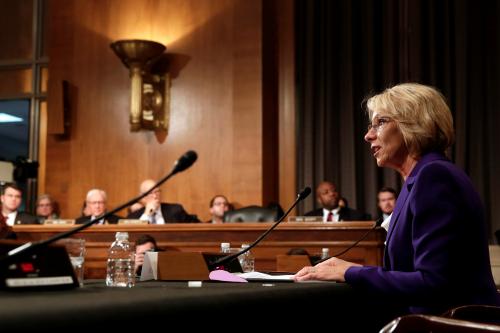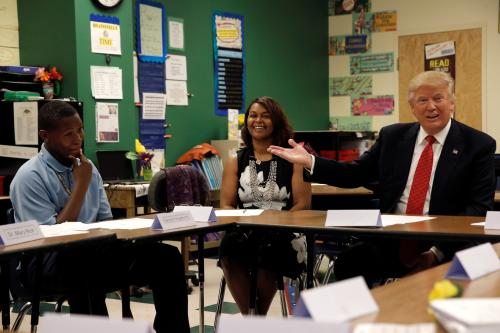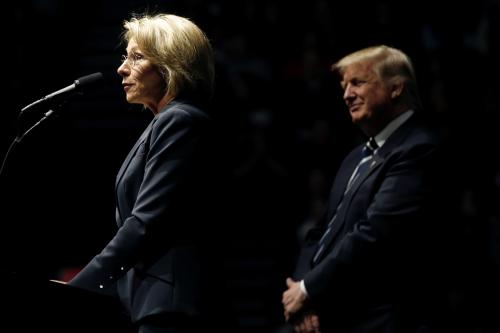 Nationwide, education was not a top issue for many voters on Election Day–far from it. At the same time, the 2018 state and national elections may have important consequences for education policy across the U.S. Here, we offer several reflections on what some of these results may mean for the future of education policy.
Nationwide, education was not a top issue for many voters on Election Day–far from it. At the same time, the 2018 state and national elections may have important consequences for education policy across the U.S. Here, we offer several reflections on what some of these results may mean for the future of education policy.
With Democrats controlling the House, expect more rigorous federal oversight
With the House under Democratic control, it is likely that House Democrats will ramp up oversight of Secretary Betsy DeVos and the Department of Education through hearings and subpoenas. Oversight may focus on issues such as state implementation of the Every Student Succeeds Act; in particular, whether states are fulfilling the law’s obligation to hold schools accountable for the success of all students, including subgroups of students such as racial and ethnic minorities, English language learners, students from low-income households, and students with disabilities. Civil rights leaders have asked Congress to step up oversight on this very issue. Other issues that Democrats may be eager to investigate include proposed changes to for-profit college regulations, Title IX policies related to campus sexual assault, and the recommendations of the national school safety commission, among others.
House Democrats cannot compel DeVos to change federal policies absent passage of legislation. But, Rep. Bobby Scott (D-Va.), the soon-to-be chairman of the House education committee, has the authority to call on DeVos and other officials in the department to testify during public hearings. Some of DeVos’s previous appearances in front of congressional committees drew intense criticism, so repeated visits to Capitol Hill could spell trouble for the Secretary. During hearings, evidence could be entered into the record that undermines the department’s position on controversial issues, such as the Department’s proposal to scrap the gainful employment rule. The House education committee also has the power to subpoena records from the Department of Education. As others have reported, Democrats are likely to use this subpoena power to investigate a wide variety of decisions made by the Trump administration.
Using oversight authority to investigate decisions made by DeVos could stall her agenda, and it could increase pressure on DeVos to revise department policies. At the same time, DeVos has thus far proved resilient to outside pressure, faithfully pursuing the Trump administration’s deregulatory agenda in spite of criticism from Democrats. This resilience, however, has occurred in the absence of public congressional scrutiny. Will an increase in oversight cause a real change in her policy decisions? That remains to be seen.
Election results could catalyze (some) partisan shifts in state-level education policy
While national-level politics are certainly important, in the case of education, most of the policymaking and implementation occurs at the state and local levels. In this context, state and local elections can have big implications for education policy. To understand how the 2018 elections might shape education policy, Table 1 summarizes the results of elections for governor, chief state school officer (CSSO), and state board of education.
Table 1
| Governors: 36 elections | Chief State School Officer: 7 elections | State Board of Education: 9 elections (8 states + D.C.) |
|
7 states flipped Democrat (IL, KS, ME, MI, NV, NM, WI)
16 D victories/23 total D governors
18 R victories/25 total R governors (+ AK and GA likely R) |
5 states remain Republican (GA, OK, SC, WY, ID)
1 partisan race too close to call (AZ)
1 nonpartisan race too close to call (CA) |
1 state remains D (CO)
3 states remain R (AL, KS, TX)
1 state remains divided (MI)
4 nonpartisan races (NE, OH, UT, D.C.) |
What do these results mean for education policy? In the seven states that flipped to Democratic governors, we may see renewed efforts to pursue progressive education agendas, such as increasing public funds for public K-12 education. For example, during his campaign, Tony Evers, a Democrat who defeated incumbent Scott Walker for the governorship in Wisconsin, proposed increasing state spending on K-12 education by 10 percent. Gretchen Whitmer, the newly elected Democratic governor of Michigan, touted universal state-funded preschool during her campaign.
However, in four of the seven states where control of the governorship flipped to Democrats, three have divided government (Kansas, Michigan, and Wisconsin) in which Republicans control the legislature. In these states, governors may face roadblocks in pursuing their agendas.
On the other hand, four of these seven states have unified Democratic government (Illinois, Maine, Nevada, and New Mexico). Governors in these four states also have the authority to appoint the chief state school officer (CSSO) and/or the state board of education (Maine and Nevada appoint both, Illinois appoints the board, and New Mexico appoints CSSO). The responsibilities of the CSSO and state board vary across states, but the authority to appoint one or both of these positions may help governors move their education agendas forward, particularly considering the additional advantage in these four states of unified Democratic control of state government. For example, new Democratic governors and their appointed CSSOs may revisit their state’s accountability plan under the Every Student Succeeds Act. Any revisions to these plans would be subject to review by the federal Department of Education.
In the states that held elections for CSSO and state board, Table 1 indicates a great deal of partisan stability. In these cases, we should not expect a partisan shift in the policies that fall under the authority of these offices in each state.
The legacy of teacher protests
One of the most memorable education storylines in 2018 was the eruption of a number of large-scale teacher strikes and protests last spring. What began with a statewide strike in West Virginia eventually developed into major public demonstrations in five other states, with minor actions in several others before waning as summer break approached. These events brought teachers and education funding to the public’s attention nationwide, supposedly propelling education forward as a key midterm issue in a number of states—the media highlighted many educators running for office and public opinion was up sharply in support of greater school funding, particularly teacher salaries.
Yet, from our vantage point today, it appears that any swell in support for education may have subsided with the teacher actions earlier this year. Ballot initiatives across the country to increase education funding or its use had a middling success rate, and ironically, were less successful in states where education spending is low, like Oklahoma and Utah. Governorships in Oklahoma and Arizona—where the teacher actions were most prolonged and widely covered—stayed in Republican hands, the party responsible for aggressively cutting education spending in both states.
The prominence of the teacher protests almost certainly shaped how politicians in both parties spoke about public education on the campaign trail—members of both parties were quick to state support for schools. However, it is not clear whether public education was the decisive factor that flipped any office in states where large protests occurred. Interestingly, though, it may have tipped the scales outside of these states: Governors Scott Walker (R-Wis.) and Bruce Rauner (R-Ill.)—both of whom lost their re-election bids—support right to work laws, which teachers’ unions oppose. And though it turns out the teachers-running-for-office story may have been a bit overblown, the election of Jahana Hayes (D-Conn.), a recognized state teacher of the year in Connecticut, to the House is a notable victory for educators.
Looking ahead to 2020
Before the ink dries on the 2018 election results, conversation is sure to move to 2020. This past election cycle offers some hints about how education might, or might not, feature in the 2020 election.
In midterm elections, the country’s attention is diffuse. Without a presidential election as a focal point, eyes are drawn to local elections and referenda. That will change in 2020. Questions about whether President Trump gets another term, and who might replace him, will dominate election coverage. This has implications for education. While education featured prominently in some places in 2018—like Arizona and Wisconsin—it ranks far down the list of issues on the minds of voters nationwide. In October, only 2 percent of Americans named education as the most important problem facing the country.
Even if the electorate doesn’t engage deeply with education in 2020, we expect educators to engage deeply with the election.
We expect education to receive little attention in 2020 and, when it does, rarely to move beyond support for more funding, more education, and more support for teachers. Democratic presidential hopefuls may try to outrun one another in their support for broadly appealing ideas like universal preschool, free college, and higher pay for teachers—even if states and localities would need to take the lead on those issues. Topics like state ESSA plans and the Higher Education Act are likely too far in the weeds to get more than superficial attention. School choice could slip from the national spotlight as voters realize that not much happened at the federal level even with unified Republican government. Democratic hopefuls might needle a fellow Democratic candidate like Cory Booker for his past support of school choice policies, but school choice seems unlikely to emerge as a defining issue in 2020.
Still, even if the electorate doesn’t engage deeply with education in 2020, we expect educators to engage deeply with the election. Politics have been on teachers’ (and students’) minds lately, with a wave of teacher strikes for better compensation and student demonstrations for gun control. Education is sure to play a role in the 2020 election, with or without the headlines to accompany it.
Hana Dai contributed to this post









Commentary
What do the 2018 midterm elections mean for education in America?
November 7, 2018